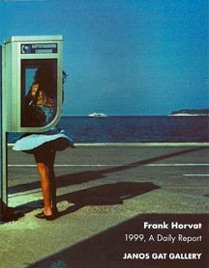The inspiration for his project about the turn of the millennium, 1999, A Daily Report, came from a conversation with Henri Cartier Bresson. During the last year of the millennium (or year before last according to some—not that it matters), my objective was to take, between January 1st and December 1st, at least one significant photograph each day (though not necessarily an excellent one). I am badly qualified to say if I achieved it; but I know that in accepting this constraint I obliged myself to remain continually open to everything around me and to question the meaning of each gesture and each object. “The most difficult thing,” wrote Goethe “is what is thought to be the simplest; to really see the things which are before your eyes”.
—Frank Horvat
Frank Horvat, 1999, A Daily Report, was first exhibited at the Fondation Dina Vierny-Musèe Maillol, Paris (October 26-November 26, 2000), and included 480 photographs. Janos Gat Gallery presents a selection of these photographs, and a CD rom with the rest of the images of the original exhibition. In conjunction with this exhibition, Staley-Wise Gallery, NY, presents Frank Horvat's 1956 Strip Tease series, recently shown at the Dina Vierny Gallery, Paris.
Frank Horvat was born in 1928 in Abbazia, Italy (formerly Austro-Hungary, now Opatija, Croatia). Having traded his stamp collection against a 35 mm camera at the age of fifteen, Horvat was already an accomplished photographer by 1950, when he met Robert Capa and Henri Cartier-Bresson (a close friend ever since) during his first trip to Paris, and decided to become a photo-journalist.
In the early 50's, after traveling to Pakistan and India as a free-lance photographer, Horvat settled in London, working for Life and the Picture Post.
In 1955, Horvat moved to Paris, where he still lives, and became a fashion photographer—using the techniques of photo journalism: real life situations, available light, and 35mm cameras. For the better part of the next two decades, traveling between Paris, London and New York, Horvat worked for Jardin des Modes, Elle, Glamour, Vogue, and Harper's Bazaar.
Since the mid 70's, Horvat has concentrated on personal projects in color, such as Portraits of Trees, Very Similar, New York Up and Down. In the 80's, Horvat was one of the first photographers to experiment with digital imaging. In the 90's, Horvat worked mainly on projects for books, such as Sculptures of Degas, Bestiarium, La Mode au Musèe Galliera, and Figures Romanes.



